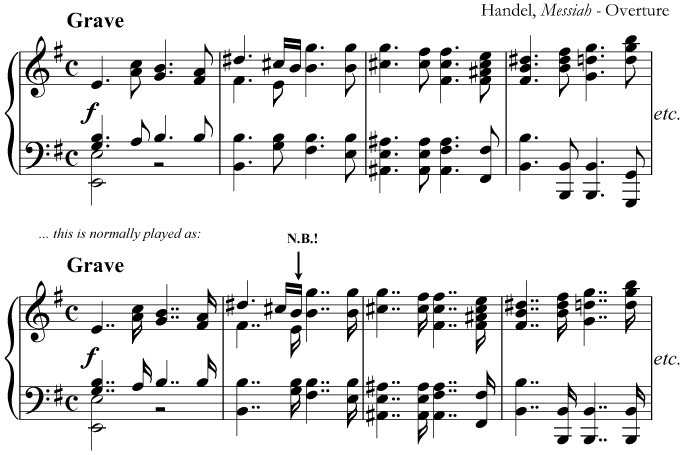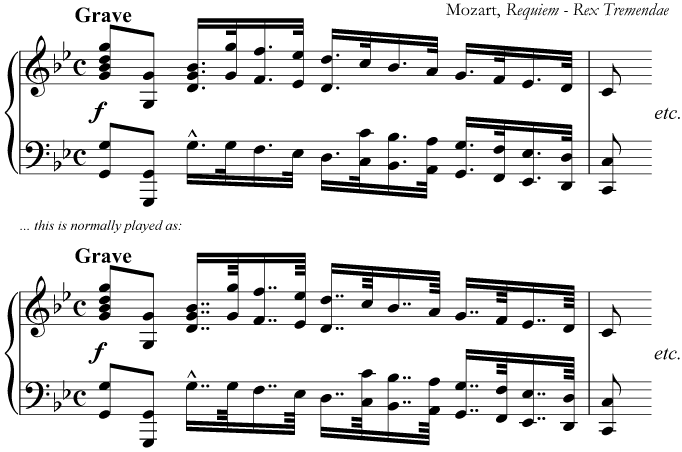Double dots
In this guide...
Key terms:
Subscription required!
To view the complete study guide, you will need a valid subscription. Why not subscribe now?
Already have a subscription? Make sure you login first!
Introduction
We have seen in Ties and dots that the effect of adding a "dot" to a note is to increase the duration of that note by half again. Now we'll meet double dots.
Dotted notes
Recall that a dot next to the head of a note increases the duration by half as much again. The effect is the same as tying on an extra note equal to that "half" duration.
A dotted crotchet, then, has the same duration as three quavers, or a crotchet tied to a quaver; similarly a dotted minim has the same duration as three crotchets, or a minim tied to a crotchet.
This is shown clearly in the diagram below:
| Construction of a dotted crotchet |
|---|
 = =  + +  |
 = =  + +  + +  |
Double dots
Notes and rests can also be double-dotted: two dots are written after the note or rest, instead of one.
The effect of the second dot is to extend the note by half the length of the first dot: so, a double-dotted crotchet is extended by a quaver (half a crotchet for the first dot) and a further semiquaver (half a quaver for the second dot).
The diagram below shows single and double dotted notes of all values, and their tied equivalents.
| Dotted note | Double dotted note |
|---|---|
 =  |  =  |
 =  |  =  |
 =  |  =  |
 =  |  =  |
 =  |  =  |
Barlines
Double dots, like single dots, cannot extend beyond a barline.
You cannot, for example, have a double dotted minim in a bar of 3/4, because that would extend beyond the duration of one bar. For a note of that duration, you must use a tie instead, as shown here:
 Double dots and barlines
Double dots and barlinesDouble dots in full bars
The double dot might seem an odd idea, and indeed it can often be confusing to read. There are however two situations in which double dots are commonly used.
A full bar dotted rhythm
If a composer wants to fill an entire bar with a note, except for a short note at the end which leads to the next bar, there are two possibilities:
- Write out notes tied together to fill the required duration
- Use a double-dot
The following example shows these two options:
 A full bar dotted rhythm
A full bar dotted rhythmIn this case, it is reasonably clear to the player what is required, whereas this can be a little less clear if ties are used.
The same principle can also be expanded by using triple dots, which are rarely seen except in this situation:
 A full bar dotted rhythm using a triple dot
A full bar dotted rhythm using a triple dotAs you can see, the effect of the third dot is to add half the value of the second dot.
Double-dotted rhythms
In music of the Baroque and Classical periods in particular (i.e. in the 17th and 18th centuries), a favourite rhythm of composers writing a piece of very serious music is a "double dotted" rhythm.
This is simply a sequence of pairs of notes, the first of each pair a double-dotted quaver and the second making up a crotchet in total. It would often be found in Baroque overtures (which were grand and serious), and also in music by Classical composers when they were seeking to sound deliberately "old fashioned", or to reference the previous century's style.
However, the double-dotted rhythm is usually not actually notated, but is intended to be played as part of the correct style and interpretation - the performers are relied upon to understand the stylistic reference.
Here is an example from the Baroque-period composer Handel (writing in the Baroque period):
 A double dotted rhythm in Handel
A double dotted rhythm in HandelYou can see in this example that by adding in the double-dotted rhythm, the music becomes a little harder to read - it looks more cluttered on the page. Therefore, the convention is write a single-dotted rhythm but to play the double-dotted rhythm.
This is particularly important to know when performing a rhythm such as that highlighted in the second bar!
Here is an example from Mozart's Requiem, from the Classical period - clearly a serious piece, intended to commemorate a death, and one which uses many stylistic references to older music to add weight and gravitas. Notice, for example, how both pieces are marked Grave, meaning "serious".
 A double dotted rhythm in Mozart's Requiem
A double dotted rhythm in Mozart's RequiemAgain, the version with double-dotted rhythms written out is much less clear to read. The stylistic convention is the same: to write single dots but to to play double-dots.
In fact, the Mozart example is often played with a slight rest before each short note, which if notated would be as follows - back to single dots, but with the rest taking the place of the 2nd dot:
 A double dotted rhythm in Mozart's Requiem, as performed
A double dotted rhythm in Mozart's Requiem, as performedThe last version is so much harder to read that you can see why composers notate a simple single-dot rhythm, and rely on a stylistic interpretation for the complete effect!
Read more...
With a subscription to Clements Theory you'll be able to read this and dozens of other study guides, along with thousands of practice questions and more! Why not subscribe now?
Revision
Are you sure you've understood everything in this study guide? Why not try the following practice questions, just to be sure!